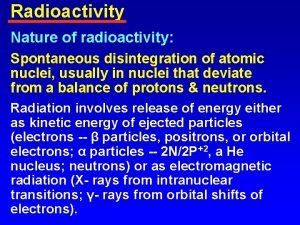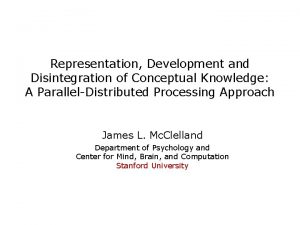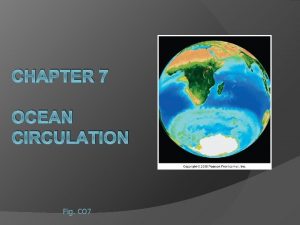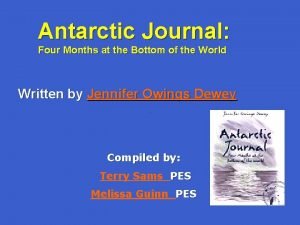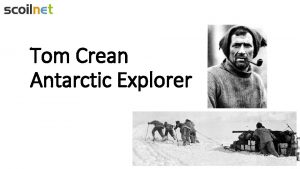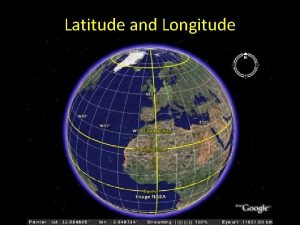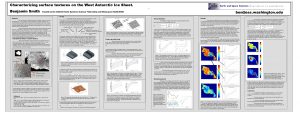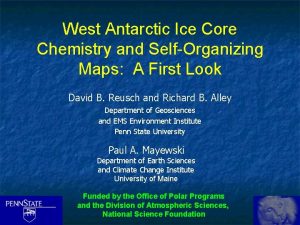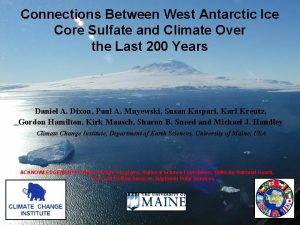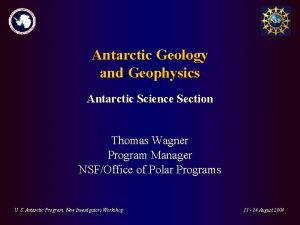A potential disintegration of the West Antarctic ice











- Slides: 11

A potential disintegration of the West Antarctic ice sheet (WAIS): Implications for economic analyses of mitigation strategies Delavane Diaz Electric Power Research Institute, Energy and Environmental Analysis group Klaus Keller Department of Geosciences, The Pennsylvania State University Department of Engineering and Public Policy, Carnegie Mellon University American Economic Association Annual Meeting January 3, 2016, San Francisco, CA Partially supported by the Program on Integrated Assessment Model Development, Diagnostics, and Inter-comparison (PIAMDDI) under US DOE grant DE-SC 0005171, the Network for Sustainable Climate Risk Management (SCRi. M) under NSF cooperative agreement GEO-1240507, and the Penn State Center for Climate Risk Management. Any opinions, findings, and conclusions or recommendations expressed in this material are those of the authors and do not necessarily reflect the views of the funding agencies. Thanks to C. Field, C. Forest, G. Garner, G. Infanger, R. Mendelsohn, M. Oppenheimer, D. Pollard, T. Rutherford and J. Weyant for helpful discussions. 1

Uncertain climate thresholds are often cited as motivation for stringent mitigation; IAMs face severe challenges in representing them e. g. , time horizon of most IAMs is only 50 -200 years Nicholas and Keller (2012) 2

WAIS may disintegrate in a threshold response to anthropogenic climate forcing; alas, the sensitivities and timescales are deeply uncertain • Marine ice sheet instability (MISI) (e. g. , Mercer 1968); potential for cliff or hydrofracture failure (Pollard et al 2015) • Instrumental record not very informative; paleo-record nontrivial to interpret for IAMs • Sparse expert opinions (Vaughan and Spouge 2002, Kriegler et al 2009, Bamber and Aspinall 2013) ~53 m SLR • Coastal damages from sea level rise (SLR) depend strongly on adaptation more stable, may gain mass decisions (Nicholls et al 2008, Hinkel et al 2014) (left) H Fricker, Scripps Institution of Oceanography; (right) www. lima. usgs. gov ~3. 3 m SLR dynamic instability 3

Analyzing climate thresholds in IAMs requires fundamental advances in the disciplines plus new approaches for transdisciplinary integration Discipline Challenges and Considerations (incomplete list) State of the Art (examples) Earth Sciences Characterize distinct threat components (e. g. , MISI, cliff, hydrofracture) Emulation of complex physical dynamics Pollard, De. Conto & Alley 2015 Decision Science IAM implementation, decision-making under uncertainty, and treatment of learning Elicit, aggregate, and implement expert opinion Keller, Bolker & Bradford 2004; Cai, Judd & Lontzek 2013; Lemoine & Traeger 2014 Vaughan & Spouge 2002, Kriegler et al 2009, Bamber & Aspinall 2013 Operations Research State space and dimensionality for multiple catastrophes Innovative solution approaches (e. g. , stochastic control, approximate dynamic programming) Cai, Judd & Lontzek 2013; Lemoine & Traeger 2014; Shayegh & Thomas 2014; Rutherford 2013 Computer Science Long time horizon for ice sheet dynamics Bakker & Keller, in review Economics SLR damage functions imply modest coastal impacts and efficient adaptation, regional aggregation Risk preferences, time preferences, and consistency Nicholls, Tol & Vafeidis 2008; Anthoff, Nicholls & Tol 2010; Diaz, in review Hall et al 2012 Philosophy Multiple objectives (e. g. , economic cost, reliability in the face of deep uncertainty, equity & distributional concerns) Descriptive discounting over long time horizons Hadka et al 2015 Keller et al 2008 Garner et al, in review Ruckert et al, in prep 4

We approximate complex geophysics using emulation with a simple hazard rate, aggregate expert opinion, and solve using stochastic optimization Hazard rate hrt gives P(collapse) in year t, conditional on ice sheet not having disintegrated Distribution based on Kriegler et al 2009 expert opinion about temperature pathway triggering WAIS collapse by 2200 e. g. , Trigger Temp = 4°C implies cumulative hazard vs. 2°C target implies no risk to left, infinite risk to right 2 5

DICE−WAIS stochastic programming IAM with endogenous trigger uncertainty DICE in a nutshell: • globally aggregated • Ramsey growth • inter-temporal optimization • mitigation cost function μ • simple climate module • climate damage functions for SLR (ΩS) and aggregate (ΩT) (see Nordhaus 1994, 2008, 2010, 2013) Diaz (2015) 6

hi H gh IG CS H T , lo HR w EA tri T gg er (distribution from Olsen et al 2012) Low WAIS reliability under optimal strategy; parametric uncertainty shows intuitive pattern AT r E R H T LOW high trigge S, low C (distribution based on Kriegler et al 2009 expert opinion on temperature pathway triggering WAIS collapse by 2200) 7

Optimal results are relatively insensitive to different assumptions about sea level rise damages and the social rate of time preference Mean SCC $21 (with recalibrated consumption elasticity) • for figure clarity outliers not shown Mean SCC $19 8

Aggressive mitigation increases the probability of avoiding a WAIS disintegration (“reliability”) • shading: points weighted by likelihood of climate sensitivity parameter 9

Setting a reliability target for WAIS increases the shadow price of CO 2 10

The conclusions are adorned by many caveats that point to urgent research needs Conclusions: • Economically optimal mitigation strategies – within a discounted utilitarian IAM with simplified geophysics – still leave a sizeable risk of triggering WAIS disintegration • Increased mitigation (i. e. , higher carbon price) improves reliability, but with a decreasing marginal return Examples of caveats and research needs: • Multiple and interacting threshold responses and failure modes • Representation of deep uncertainties • Increased realism of the biogeochemical and geophysical dynamics • Decision making under uncertainty for coastal adaptation response • Extended time horizon and uncertain state space • Consideration of additional policy objectives (e. g. , reliability, prioritarianism, ambiguity aversion) 11
 Quality control definition
Quality control definition Theory of positive disintegration
Theory of positive disintegration Radioactivity as spontaneous disintegration
Radioactivity as spontaneous disintegration Theory of positive disintegration
Theory of positive disintegration Disintegration definition
Disintegration definition Dissolution vs disintegration
Dissolution vs disintegration Disintegration definition tablet
Disintegration definition tablet Temporal pole function
Temporal pole function Antarctic circumpolar current
Antarctic circumpolar current Antarctic journal four months at the bottom of the world
Antarctic journal four months at the bottom of the world Explore with tom
Explore with tom Antarctic circle
Antarctic circle


